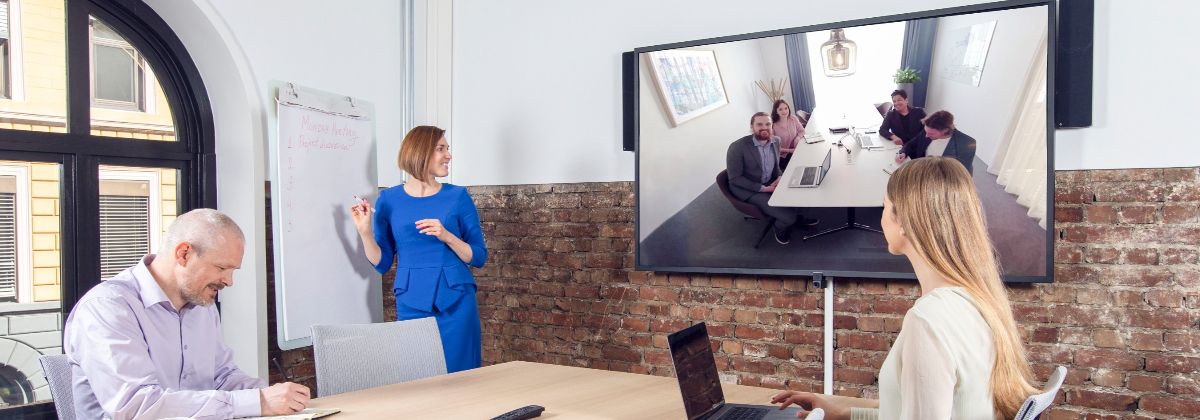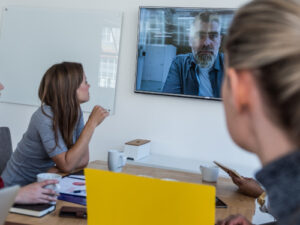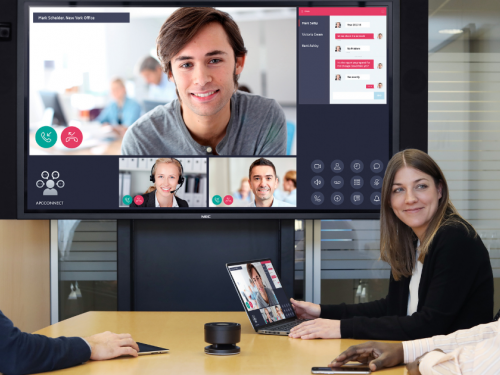
The Hybrid Working Future
The COVID-19 pandemic has shown that not only is remote working feasible but can also be as productive as office-based working. Nearly every office-based business will have experienced one form of remote working or another over the course of 2020 and well into 2021.
There are of course many advantages to working from home, such as restoring more of a work-life balance and being able to focus on work away from the distractions of the office.
 A US survey carried out by Owl Labs found that despite some difficulties associated with working remotely, 77% of respondents agreed that after COVID-19, having the option to work from home would make them happier.
A US survey carried out by Owl Labs found that despite some difficulties associated with working remotely, 77% of respondents agreed that after COVID-19, having the option to work from home would make them happier.
The same report found that during COVID-19, 75% of people were just as productive or more so while working from home, and that after the pandemic is over, 80% of respondents expect to work from home at least 3 times per week. With home working additionally resulting in huge savings on commuting time and money spent, there is definitely as much a precedent as there is a demand for home working and the increased flexibility it provides.
However, working from home during lockdown has not been smooth sailing for everyone. Stats show that employee engagement has dropped, with communications becoming limited to smaller and smaller teams.
Continuing Office Contact
In Microsoft’s Annual Work Trend Index from March 2021, it was reported that 67% of surveyed workers wanted more face-to-face working and collaboration following the pandemic. The report also detailed how analysis of Microsoft Teams and other Office applications showed team-wide communications had dropped by around 5%, whereas one-to-one messaging had increased by 87%.
This is a clear symptom of fatigue associated with the necessary interactions of remote working, such as instant messaging, emails and video conferencing. While these certainly facilitate quick communication, over time they can be draining. True face-to-face, in person interaction has been absent throughout 2020 for most people, so returning to an office environment can be important in helping to re-establish this connection between employees and provide a positive mental health benefit.
Many people would undoubtedly struggle to transition back to full-time office working, especially those needing to provide childcare, look after pets or simply save money by working at home. The important insight to take away from the past year is that a hybrid approach provides an ideal middle ground, allowing teams to have some days on-site and others at home. This would provide all the benefits of office working while giving the chance for additional flexibility and freedom.
This sentiment is definitely shared by some of the world’s top AV manufacturers, as trends in purchases over the past year have shown an increased reliance on AV equipment to provide the right setup for hybrid working and facilitate quick, seamless and high-quality communications across organisations.

Best of Both Worlds
In an article from AV Magazine, Barco’s Nathalie Leignel Andersen said that “creativity and community are being stifled” in an entirely remote working model and that companies will be “completely rethinking the use of meeting rooms for shorter, livelier collaboration sessions, enabling multiple people to participate and share seamlessly.”
One of the casualties of COVID-19 was work-related travel, whether for commuting or attending meetings. This is not necessarily a bad thing, as video conferencing has carried the load and allowed companies to cut back on travel expenses and reduce wasted time.
As Avocor’s Glenn Wastyn said in the same AV Magazine article: “Video conferencing offers everyone more efficiency and a better quality of life, saving those face-to-face meetings for when they are truly valuable.”
As we now approach the second half of 2021, with COVID-19 lockdown restrictions now relaxing or lifting entirely in most countries, it is clear that most people will be considering how they can adapt to a hybrid working culture. It is hard to tell what the long-term effects of the pandemic will be, or if future lockdowns will be necessary to curb the spread of the virus, however it is safe to say that businesses will be far more prepared for change than they were in March 2020.
No matter the industry and no matter some businesses may feel about it, hybrid working is here to stay. So, the questions that must be asked are:
- How can installing AV equipment help companies to best prepare for this new work model?
- Why and how does this way of working benefit a business?
5 Ways to Enable Hybrid Working Using AV Equipment
In a hybrid working environment, businesses require a common equipment setup across their entire workforce, no matter where they are. Not only will this enable better use of cloud-based, collaborative software, but also ensure quick and seamless communication across internal teams and external clients.
As the hybrid model has become more widespread over the past 2 years, so too has the need for Audio Visual solutions that provide communication and collaboration, while also offering additional features that improve productivity, or at the very least bring businesses up to speed with the latest technologies.
 We now want to explore how AV systems such as digital screens, video conferencing setups and custom-built collaboration spaces can allow for an efficient, productive and dynamic way of working.
We now want to explore how AV systems such as digital screens, video conferencing setups and custom-built collaboration spaces can allow for an efficient, productive and dynamic way of working.
1. Putting productivity front and centre
Networked AV systems make collaboration easier than ever for your workforce, no matter if they are in the office or based remotely. This kind of setup might involve huddle rooms where devices can be connected to digital screens, or boardrooms with conference call and video conferencing capability.
Investing in the most current systems will keep the video conferencing/streaming quality high and will allow for quick calls with clients and other branches of your business that save commuting time between face-to-face meetings.
Over the past year, many office workers will have found they can work just as productively at home, so keeping things flexible through fast, efficient AV-enabled collaboration can help the overall productivity and morale of your team.
2. Keep things engaging
Video conferencing alone can become stale – we’ve all experienced “Zoom fatigue” at some point during lockdown and working from home. By utilising innovative AV systems such as interactive touchscreens or ‘Bring-Your-Own-Device’ (BYOD) rooms, you can keep meetings dynamic and engaging for your team.
3. Create an impression
Remote and hybrid working is here to stay for a lot of businesses, which means many of your clients or potential prospects will be adopting the approach. This brings an expectation for high-quality video conferencing capabilities, cloud-based collaboration and meeting rooms with top-end digital screens for delivering presentations.
Investing in AV systems is more about stepping in line with the times however, as they can allow you to simply create a good first impression by showing that your company makes the audio visual side of meetings and collaborative working as intuitive and high-fidelity as possible.
4. Streamlining your hybrid working
Integrated AV systems, designed by an experienced AV supplier, can help to streamline your stock of office equipment and devices required for remote or on-site working. Businesses can also enable better room booking and meeting scheduling through display panels.
Further streamlining things is the capability for AV systems to improve way-finding for on-site visitors, with everything from digital displays to touchscreen panels allowing for contact-free check-in on your premises.
5. Connectivity at the core
What AV equipment does best within the workplace is keep people connected. For all the advantages of hybrid working, the downside is reduced in-person interaction between employees, managers and client alike.
 However, by employing integrated AV systems companies can restore the visual interaction of the workplace, keeping people connected through face-to-face meetings and working sessions over video conferencing and digital streaming.
However, by employing integrated AV systems companies can restore the visual interaction of the workplace, keeping people connected through face-to-face meetings and working sessions over video conferencing and digital streaming.
This is by far the best way solution to allow for remote working without sacrificing the human interaction that is so important for employee motivation, mental health and satisfaction, as well as for personable interactions between different businesses.
5 Key Benefits of AV-Enabled Hybrid Working
Now that the hybrid working model has been shown to work and many businesses have adopted it, other organisations may be in the position of considering it.
Back near the end of 2020 and after several months of COVID-19 lockdown, the phrase being thrown around in the press was ‘the New Normal’. Some people may initially be hesitant or sceptical, however there are many factors that allow for remote or hybrid working to benefit a business, both from a financial standpoint and one of employee wellbeing and productivity.
1. Health at the forefront
The mental and physical wellbeing of staff has become a bigger priority than ever and that was even before the pandemic hit. A hybrid approach allows for employees to reprioritise the all-important work-life balance, while allowing smaller teams to operate within your premises to reduce contact time between employees where physical distancing is a concern.
Having the flexibility of an AV-enabled hybrid workplace provides continuity of work across home and the office so you can focus on keeping facilities clean and allow employees to balance their work and home lives.
2. Downsize your square-footage
Something many businesses have found during lockdown was the cost saving associated with working from home versus running a full office. Switching to hybrid working can allow you to downsize office space and require fewer meeting rooms.
It also means less travel to and from client meetings, which helps employees save on their commute if that is a concern. Investing in AV systems like video conferencing can yield long-term savings if it means your company is able to move to smaller, more affordable premises, or even go completely remote.
3. Creating collaboration
The greatest step in AV tech over the past decade by far has been the introduction of cloud-based IT systems. On a cloud-based system, your team can work seamlessly across home and the office, reaping the benefits of each while simultaneously working quicker and easier than before.
This is especially beneficial across large, disparate organisations where work needs to be collaborated on in real-time by teams working miles apart. A hybrid workplace also allows for greater working between mixed permanent and freelance teams, as well as and between your business and your clients.
 4. Environmental impact
4. Environmental impact
An under-appreciated benefit of remote and hybrid working is the effect on the planet. In a time where carbon footprint is of greater concern than ever, some companies may want to take the approach of downsizing their premises to lower energy consumption and reduce the need for employees to commute.
5. Flexibility and adaptability
Hopefully nothing like COVID happens again, but after the trials and tribulations of 2020, businesses will now be better prepared if it does. The hybrid model keeps businesses agile and ready to adapt to difficult circumstances. It also helps when workers may struggle to come into the office due to sickness or injury, in case of emergency or if they are providing care to someone.
Plus, AV systems can better enable collaborative, cloud-based working that lowers paper consumption. If a business is looking to prioritise its environmental impact and reduce its carbon footprint, then AV-enabled hybrid working can be an excellent place to start.
It also allows businesses to hire staff based much further away who can work remotely. The world learned a very quick lesson in adaptability during lockdown, so carrying forward a dynamic and flexible approach through hybrid working will pay dividends in many circumstances.
To integrate an AV-enabled hybrid working model into your business, working with a specialist AV supplier will provide the flexibility to create the ideal setup for your specific requirements with access to an extensive range of products from leading manufacturers.
Integrating AV Technology
You may wish to discuss a full suite of new AV solutions for each aspect of your business, or simply wish to upgrade your existing AV capability as part of an office-wide renovation. Whatever your requirements, the team at Mediascape can be there to help.
Mediascape Ltd is Scotland’s leading, full-service audio visual specialist. We have a dedicated team of professionals operating across the country able to design, supply install and maintain a full range of AV solutions for your business.
We specialise in delivering bespoke solutions tailored to each business, so you can be sure that we will coordinate the best solution to fit your hybrid working approach that empowers your workforce while staying ahead of current technologies and AV innovations.
The best way to find out what we can provide for you is to get in touch and discuss your requirements.


 4. Environmental impact
4. Environmental impact

